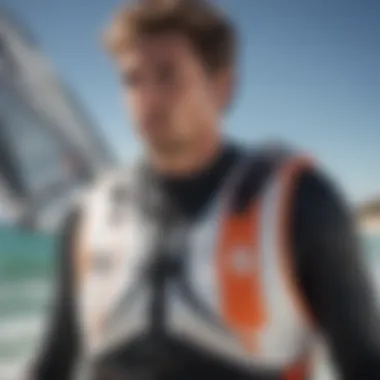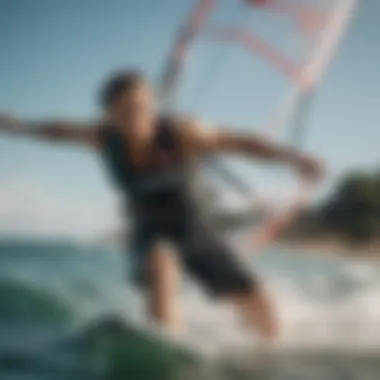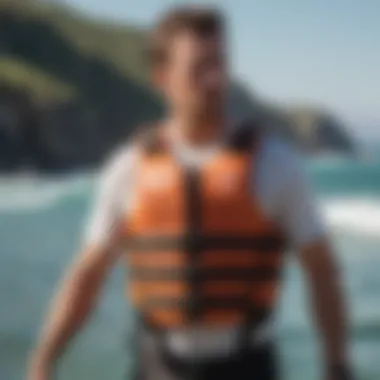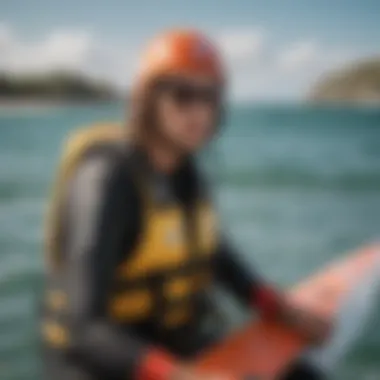The Role of Impact Vests in Windsurfing Safety and Performance


Intro
Windsurfing merges the thrill of sailing with the excitement of surfing. In this vibrant sport, safety should not be underestimated. Impact vests have emerged as a critical element of equipment for active participants. Unlike traditional life jackets, these vests are designed specifically for windsurfing. They offer significant padding to the torso without increasing bulk. Furthermore, the advancements in materials used in these vests cater to both comfort and protection, promising athletes improved safety and peace of mind on the water.
Wearing such protective gear might influence an athlete's psychological state, providing instilled confidence. Athletes can push their performance boundaries when they feel secure. Therefore, investigatng the impact vest industry's growth and changes makes this a timely and relevant analysis.
In the following sections, the specific features of vests, their benefits, and the evolving perceptions surrounding their use will be dissected. This comprehensive guide aims to explore how impact vests can enhance the windsurfing experience while prioritizing safety and well-being. Let's begin with a detailed overview of these essential pieces of equipment; understanding their implications is key for every windsurfer.
Impact Vests: Design and Functionality
When examining the keys to impact vests, it is essential to consider design and functionality. Impact vests vary in design, each suited to certain your preferences and the needs of different windsurfing conditions. Often, they are constructed from neoprene or similar materials, ensuring a snug fit while allowing flexibility. The is an important feature since windsurfing involves a range of body movements.
Safety Features
Crash impact is a concern during activities at high speeds, hence, safety becomes the primary feature of impact vests. Enhancements such as multi-density foam panels effectively absorb shocks and protect the rider's torso. Some vests also come with corded adjustments for a custom fit, ensuring stability while riding the waves.
Technological Advancements
Technological innovations have elevated the standards of impact vests. Many manufactures test their products against rigorous safety standards. Others have even started usign inflatable compartments for even better protection mechanisms. This is especially useful during extreme conditions or terrains where risks heighten significantly.
Aesthetics and Comfort
Seeing trends in color, style, and fit are also becoming more important among windsurfers. Available in multiple colors and styles, impact vests merge fashion with functionality. The emphasis on comfort also means allowing ample ventilation and water drainage to keep chills away, which is vital for prolonged sessions.
The Benefits of Wearing an Impact Vest
The advantages of donning protective gear extend beyond personal well-being. Aside from the primary protection against concussions or fractured ribs, many physical benefits arise. The following areas showcase how these vests significantly contribute to a windsurfer’s performance:
- Confidence Boost: Athletes exhibit greater daringness in challenging conditions when equipped with protective gear.
- Improved Stability: With a proper fitted vest, it adds buoyancy, ensuring an enhanced feeling of balance.
- Injury Prevention: Reduced risks occur during falls, leading to more enjoyable sessions.
- Thermal Insulation: Some impact vests provide insulation against cold water into cool winds.
Therefore, an impact vest remains an imperative part of gear for anyone aiming to enjoy the sport responsibly.
“Using protective gear significantly enhances psychological reassurance. Feeling secure enhances performance in high-pressure activities like windsurfing.”
Evolving Perceptions of Safety Equipment
Historically, safety equipment was met with skepticism by some, often viewed as cumbersome or unnecessary. Over time this contributed to increased fear of restrictions on performance. However, the tide may be turning in terms of perspective. Many renowned athletes have openly endorsed impact vests. Their influence has helped reshape the narrative around safety in windsurfing communities. Today, events are amazed by the diversity of vests available, with competitions often factoring in partnerships with safety equipment manufacturers.
Perceptions on impact vests continue to evolve. Compliance with safety standards must no longer seem like a burden or deterrent but rather an element crucial to responsible windsurfing culture. Attitudes toward investment in safety gear appear to link directly with growing industry standards and the ongoing education efforts within the sport.
In summary, impact vests emerge as multi-faceted gear essential for windsurfers. They deliver protection, resilience, and confidence, aiding in improving athletic performance in often unpredictable conditions. Having touched on design, functionality, and evolving perceptions, others explored this topic merits equal attention, such as equipment maintenance and emerging tech.
Foreword to Windsurfing and Safety Gear
Windsurfing is a dynamic and exhilarating sport that combines elements of surfing and sailing. It provides athletes with a unique experience on the water, where they harness the wind to propel themselves across the surface. This sport is not only demanding but can also be unpredictable, subjecting participants to varied conditions. It is crucial to pay attention to safety to minimize risks and maximize enjoyment. In this section, we will discuss the essential role of safety gear, particularly impact vests, in ensuring the well-being of windsurfers.
Overview of Windsurfing as a Sport
Windsurfing involves balancing on a board while manipulating a sail attached to a mast. It requires skill, strength, and an understanding of wind patterns. Windsurfers can perform tricks, race against one another, or enjoy relaxed sailing. However, the thrill of the sport comes with its share of dangers. A misstep can lead to falls or collisions, injuring the rider. Still, with proper training and the right equipment, such risks can be mitigated effectively.
Importance of Safety Equipment
Safety equipment is vital in minimizing potential injuries during windsurfing. Key pieces of gear greatly improve the safety of participants. One must consider the following points:
- Preventing Injuries: Wearing safety gear such as impact vests safeguards a rider during unexpected falls or crashes.
- Legal Regulations: In some regions, local laws mandate the use of specific safety gear.
- Confidence Builder: Knowing you are well-protected allows you to push your limits, enhancing your performance and enjoyment.
What is an Impact Vest?
Impact vests are an essential piece of safety gear in windsurfing. They are designed to provide protection and support for riders who navigate the challenging conditions on the water. Understanding their role establishes the connection between safety and performance in this exhilarating sport. In this section, we will define what impact vests are and highlight their key features and materials.
Defining Impact Vests


An impact vest serves several purposes. Primarily, it cushions the body against sudden impacts. This can be especially crucial during falls where the rider may hit the water or their board. Unlike traditional life jackets, impact vests are lightweight and more streamlined. They allow for better mobility, which is vital in a high-speed sport like windsurfing. The design focuses on enhancing safety without sacrificing performance, a balance important to riders.
These vests also offer some level of buoyancy. However, their primary function is to “absorb” impacts rather than to keep the wearer afloat. This makes them suitable for use in waves or high winds, where severe falls could lead to injury. Riders can depend on impact vests to add a layer of confidence to their practice, allowing for more freedom to push athletic limits.
Key Features and Materials
Impact vests are carefully crafted to include several key features aimed at maximizing protection and comfort. Typically, vests consist of:
- High-Density Foam: This is a common material used that absorbs shock and impact. The foam is distributed across strategic areas of the vest.
- Adjustable Straps: This enables a snug fit around the torso, which is important for both safety and comfort during long sessions on the water.
- Breathable Fabrics: The outer layer often includes materials that wick away moisture. This indicates either good performance in warmth or cool conditions.
- Lightweight Design: This makes movement easier, allowing for a better range of motion while riding the board.
By concentrating on these elements, manufacturers provide protection that feels almost invisible, thus allowing enthusiasts to engage more fully with their windsurfing passion. Beyond the basics, innovations in material science, such as the use of advanced composites, continue to influence how these vests perform and offer future advancements in function and comfort.
Investing in a quality impact vest is investing in your safety. More than just comfort, it represents a commitment to maintaining well-being while pursuing your windsurfing passion.
In the next sections, we will delve deeper into the benefits of using impact vests and examine how these protections enhance overall performance on the water.
Benefits of Using Impact Vests in Windsurfing
The integration of impact vests into windsurfing represents a pivotal shift in athlete safety and performance enhancement. It is crucial to understand how these specialized vests contribute to multiple aspects of the sport, primarily focusing on injury prevention, buoyancy, performance enhancement, and the adaptability to volatile weather and water conditions. These benefits not only serve to protect athletes but also allow them to push their limits with a greater sense of security.
Injury Prevention
Injury prevention is one of the most critical reasons for using impact vests while windsurfing. Each session on the water presents inherent risks. Windsurfers can face falls, collisions with equipment, or interactions with the boards and fins in challenging conditions.
Impact vests are designed to absorb and diffuse energy during impact. They are secured to the body and contain layered padding that meets safety standards. Research indicates that these vests can significantly reduce the severity of injuries such as bruises, lacerations, and even concussions. For example, a well-designed vest, like the Mystic Marshall Impact Vest, can be key to avoid bilateral injuries during sudden falls, where the body hits both the board and the water simultaneously.
By offering a layer of protection, impact vests can provide peace of mind, allowing athletes to focus on technique and performance rather than potential injuries.
Buoyancy and Performance Enhancement
Buoyancy is another vital characteristic of impact vests that complements both safety and overall performance. These vests usually include some level of flotation material, allowing riders to remain afloat if they fall into the water. This feature is incredibly valuable, especially during competitions where achieving distance and speed is crucial. By providing an effective buoyancy solution, athletes can conserve energy, which enhances their performance by allowing them to recover quickly.
Performance is not solely linked to buoyancy, although marrying a suitable impact vest with optimal board selection plays a large role. The right vest can enhance agility and maneuverability in rough waters, allowing the rider to experiment with more daring tricks without the constant worry of falling hard. Jerseys like the ION Assault Vest go beyond safety; they synergistically enhance the overall windsurfing experience through strategic feedback on performance loops.
Weather and Water Conditions Adaptation
Weather and water conditions can change dramatically and unexpectedly in windsurfing, creating different levels of difficulty and risk. An impact vest equipped with specialized materials can adapt to various elements, providing comfort and protection whether surfing on calm lakes or chopping through ocean swells.
For instance, certain models often include thermal materials that insulate the body against cool waters, extending the overall time one can spend in the water — an obvious advantage. A wet or damp body can hinder agility and increase the risk of hypothermia. With effective insulation, as seen in the O’Neill Thermo Layer vests, riders have an advantage in challenging environmental conditions.
Moreover, added visibility features on many vests help maintain safety not only for the rider but also for others in those unpredictable waters by making it easier for them to be seen. It integrates practical considerations into the design, as maintaining visibility in unpredictable waters during a windsurfing session is crucial.
A wel-designed impact vest can ensure that performance does not come at the cost of safety, striking a balance vital for windsurfmers looking to advance their skills.
To summarize, impact vests are essential tools in windsurfing not just for injury prevention but also for enhancing buoyancy and performance while adapting to various weather and water conditions. Choosing the right impact vest is an investment in safety that yields significant benefits on the water.
Technical Aspects of Impact Vests
Impact vests serve not only as safety equipment, but their technical aspects greatly influence their effectiveness in windsurfing. Understanding how these vests are constructed and the innovations behind them contributes to their performance, safety, and adaptability in high-risk environments.
Construction Techniques
The construction of impact vests involves several intricate techniques designed to provide security while maximizing comfort and mobility. Typically, these vests are tailored with multi-layer designs, which integrate foam padding, rigid shells, and textile materials.
The layering serves multiple significant purposes: protecting the rider against impacts and controlling buoyancy. A well-designed vest balances out the trade-off between insulation against water pressure and flexibility when maneuvering on the water. This intricate balancing act contributes to reducing the risk of serious injuries.
Another factor to consider is the fit of the vest. Adjustable straps and diverse sizing help riders find the optimal fit. A snug garment reduces the likelihood of the vest riding up on impact, ensuring that it does remain where most needed during a fall.
Innovations in Materials Science
Developments in material science have raised the bar for the performance and effectiveness of impact vests. Manufacturers constantly look for fresh materials that enhance protection while keeping weight low. In recent years, advancements like closed-cell foam, energy-absorbing polymers, and lightweight composites have been at the forefront of this evolution.


The use of closed-cell foams provides excellent buoyancy and insulation. Such materials resist water absorption which, favorably, maintains their parameters during extended usage in the sea. Additionally, energy-absorbing polymers react dynamically to impact, dispersing energy on collision which enhances rider safety.
Moreover, breathability and durability have also improved due to the incorporation of high-performance textiles. Fabrics like Nylon and Spandex are used more in vests, supporting the need for elasticity and resilience against saltwater degradation. Riders do faces they can withstand rough waves reliably without compromising core functionality.
As innovations continue, future impacts on the designs of windsurfing impact vests could redefine the standards of safety equipment.
Psychological Effects of Wearing Impact Vests
Wearing impact vests in windsurfing does not only offer physical protection; it also brings about significant psychological benefits. Understanding these effects is essential for both new and seasoned riders. Safety perceptions shape behavior and performance, evolving the rider's mentality toward overcoming fear and anxiety linked to potential accidents.
Impact on Confidence of Riders
The act of donning an impact vest can significantly boost a rider's self-confidence. When participants know they are wearing protective gear, they often feel more secure, leading to enhanced performance. Confidence is relevant in extreme sports like windsurfing, where skill levels fluctuate, and others navigate challenging conditions.
The relationship between safety gear and riding confidence has shown noteworthy positive impacts. Individuals tend to experiment more and push their limits when wearing impact vests. This sense of security can translate into improved agility and adaptability while riding.
Several studies suggest this correlation:
- Increased attempts of advanced maneuvers.
- Reduced self-doubt about their endurance skills.
- Enhanced willingness to ride under variable conditions.
While not infallible, the effects of psychological reinforcement provided by an impact vest contribute to a healthier outlook toward both competition and leisure.
Community Perceptions of Safety Gear
The perception of impact vests within the windsurfing community is an interplay of tradition and evolving best practices. Gateway discussions revolve around safety gear often yield various views, impacting decisions among participants.
Many in the community emphasize education on the importance of safety gear. Evaluating how modern technology has made impact vests lighter and more effective can enhance their appeal. Understanding their form and function reduces resistance to adoption.
Likewise, younger and modern riders are reshaping the narrative around safety gear. Some appreciate the enhanced styles of contemporary impact vests which make them feel fashionable. On the contrary, traditionalists may challenge the necessity of these advancements and their practicality.
Positive perceptions may come from:
- Trusted endorsements from experienced riders.
- Awareness and knowledge about injury statistics.
- Social media portraying safety-first attitudes.
Case Studies and Real-Life Applications
In the world of windsurfing, understanding the real-life applications and case studies regarding impact vests can provide crucial insights into their effectiveness and practicality. This analysis is particularly significant as it goes beyond theoretical discussions, showcasing tangible results seen in monitoring accident statistics and feedback from athletes. The assessment becomes a valuable tool not just for athletes, but also for designers and stakeholders in the windsurfing community, illuminating the profound influence that impact vests can have on safety and performance.
Accident Prevention in Competitive Events
Within competitive settings, the occurrence of accidents is a notable concern. High-speed maneuvers and whip-like turns can result in falls and collisions. For this reason, impact vests have proven essential. Various case studies highlight that individuals who wear these vests during competitions are notably less likely to suffer severe injuries compared to those who do not use them.
"Impact vests are not just a trend—they are a vital component of safety that many serious athletes now consider essential."
Several competitions have documented a decrease in injuries attributed to protective gear like the impact vest. For example, during the World Windsurfing Championship, data showed a stark difference in injury rates before and after mandating the use of impact vests for all competitors. Participants reported more confidence, knowing that they had reliable protection in case of mishaps. Also, the decreased pressure due to improved safety allows competitors to focus better on strategy and technique without excessive worry.
Comparative Analysis of Non-Vest vs.
Vest Usage
A detailed comparison of non-vest participants with their vest-wearing counterparts demonstrates significant advantages in safety and performance. Those using impact vests often report a better sense of control and buoyancy. This aspect enhances performance, particularly when navigating challenging bursts of wind and turbulent waters.
Polls conducted in windsurfing communities show that younger riders tend to wear vests more frequently, aligning with their higher risk-taking behavior. It's equally essential to analyze the impact this trend has on older or more seasoned athletes.
In a comparison study involving frequent injuries evaluated over two seasons, results showed:
- Non-Vest Users: Reported injuries included bruises, spinal strains, and concussions.
- Vest Users: Experienced far fewer incidents, with reported injuries primarily limited to minor abrasions and muscle strains.
The substantial advantage here is not merely anecdotal; solid numbers and feedback from participants substantiate the protective claims made about impact vests. As this protective gear continues to evolve, it becomes incumbent to further encourage the sporting community to fully embrace innovations in safety apparel.
In summary, the insights gained from case studies clarify the practical benefits of impact vests. Recognizing how these are perceived in competitive settings can also inform broader industry recommendations on safety standards that might adjust based on continuous improvements in vest technology.


Challenges and Limitations
Comfort vs.
Protection Trade-Offs
Wearing an impact vest during windsurfing can often result in a trade-off between comfort and protection. On one side, vests are designed to provide essential protection during falls or impacts with the water. The materials used in various vests can be bulky, which sometimes can restrict movement. This is problematic for windsurfers who rely on agility and quick response times to maneuver through shifting winds and waves.
When opting for greater protection, the added layers and stiffness of some product models can lead to discomfort. Riders may sweat more and experience reduced body temperature control. Therefore, the challenge lies in choosing a vest that protects without heaving making the rider uncomfortable.
To mitigate these trade-offs, manufacturers are exploring innovative designs that maintain user comfort. Such advancements include lighter materials and ergonomic engineering that prioritize user mobility without compromising vital protection. Additionally, riders should consider how a supposed sacrifice of either comfort or support could influence their performance overlong durations on the water.
Key Aspects to Note:
- Finding a balance is essential in choosing an impact vest.
- New innovations are constantly reshaping comfort levels.
- A well-matched vest has the power to enhance the overall experience of windsurfing.
Market Accessibility and Cost Factors
Market accessibility and cost associated with impact vests are critical considerations. The prices of quality windsurfing vests vary widely. Premium models are engineered refinement but can lead to sticker shock for many enthusiasts. This financial barrier can limit many aspiring riders from investing in the necessary safety equipment.
Moreover, availability can be hit or miss. In some areas, high-quality vests might not be stocked due to limited demand or sway towards different water sports gear. Buyers who live remotely or who lack access to specialized stores, face difficulties in sourcing adequate equipment. As a result, safety gear might be overlooked building risks when individuals venture into windsurfing.
It's important for manufacturers and retailers to understand their target audiences. There are rising initiatives toward offering safety gear at varied price points to meet diverse consumer needs. Public awareness campaigns should highlight product benefits and dangers associated with inadequate safety attire, pushing for a wider acceptance of life-saving equipment.
Investing in a quality impact vest could be the difference between enjoying windsurfing and facing severe injury.
Considerations in the Era of Growing Popularity:
- Increased visibility of alternative affordable options can promote wider accessibility.
- Retailers must balance inventory with community needs.
- Awareness campaigns create demand, ensuring ample access.
Future Trends in Impact Vest Technology
The continuous evolution of impact vest technology is crucial for improving the safety and overall performance of windsurfing enthusiasts. As the sport evolves, so do the dangers and challenges associated with it. This section focuses on perceived advancements that are redefining the vests designed for windsurfers. Keeping an eye on these trends is important not only for individual athletes but also for manufacturers and the sporting community as a whole.
Emerging Technologies in Safety Gear
Recent developments in material science play a prominent role in impacting vest functionality and design. Innovations like impact-resistant foams, moisture-wicking fabrics, and advanced ergonomic designs have transformed how protective gear is perceived in water sports. Some key elements include:
- Smart Materials: These materials adapt to environmental conditions, providing optimized support under flexible conditions. They offer both comfort and maximize injury prevention without hindering movement.
- Integrated Safety Features: Features such as built-in flotation, GPS tracking, or even automatic inflation technologies are making vests safer. These adjustments are meant to improve visibility and response in emergencies.
- Personalization Options: The demand for personalized gear grows, encouraging manufacturers to develop customizable designs that cater for individual sizes and preferences.
The integration of these elements reflects a deeper understanding of the needs within high-performance sports. It elevates safety gear from basic necessities to highly specialized equipment.
Sustainability Considerations in Material Use
In an era where environmental awareness is ever-increasing, sustainability in material production becomes vital, especially in sports equipment. Notably, designers are opting for biodegradable materials and eco-friendly manufacturing processes. Key considerations here include:
- Biodegradable Alternatives: Use of materials that naturally break down without releasing toxic substances is an increasing trend. This mitigates the environmental impact of discarded products.
- Recycled Components: More brands are utilizing recycled plastics and fabrics to manufacture vests. This not only reduces waste but lowers resource consumption related to new product creation.
- Longer Life Cycle: Many brands are working to enhance vest durability, promoting products that can withstand harsh conditions with effective maintenance. This approach leads to fewer replacements, minimizing waste over time.
Vests that incorporate these sustainable practices are not only beneficial for athletes but help cultivate a culture of environmental responsibility. They promote utilization without harming nature.
Focusing on technological and sustainable innovations is essential for the future of windsurfing safety gear. Companies adjusting to these trends can ensure they meet both athlete expectations and environmental goals.
By observing and embracing trends in emerging technologies and sustainability, the windsurfing community can look forward towards a safer on-water experience. Adjustments in gear not only promise heightened protection but also signify a thoughtful future direction for the equipment that shapes extreme sports.
Epilogue
Recap of Impact Vest Importance
Impact vests play a critical role in windsurfing, bridging the gap between safety and performance. Their design focuses on protection, allowing athletes to engage in high-risk maneuvers without prominent fear of severe injuries. The vest’s construction, often featuring reinforced materials, minimizes the impact from falls and collisions with the water or equipment. Moreover, the buoyancy properties of vests can enhance overall stability during rides and help riders remain afloat in unexpected situations.
Various case studies underscore how impact vests have contributed to decreasing the frequency and severity of windsurfing injuries over the years. They provide a safety layer, reassuring users as they navigate challenging water conditions. As windsurfing continually evolves, so does the role of these vests, reinforcing that they are essential beyond mere accessories—they are a fundamental aspect of responsible windsurfing.
Encouragement for Safety in Windsurfing
The increasing participation in windsurfing calls for a joined effort in promoting safety measures within the community. Wearing an impact vest should not be viewed merely as an extra piece of gear but as a vital component for safe enjoyment of the sport. Emphasizing safety gears helps cultivate both responsibility and camaraderie among athetes.
It’s essential to conduct thorough research on available products and select a vest that suits individual needs and riding conditions. Factors to consider include fit, buoyancy, and level of protection offered. Communities should value practice over seeming bravery by fostering and encouraging a culture of sensible safety.
Ultimately, wearing an impact vest signifies respect not only for one’s own safety but also reflects consideration for fellow surfers encountered on the water. As participants recognize the importance of such measures, a cultural shift can help in reinforcing the safety-first mentality crucial for thrill-seekers navigating wind and water.







